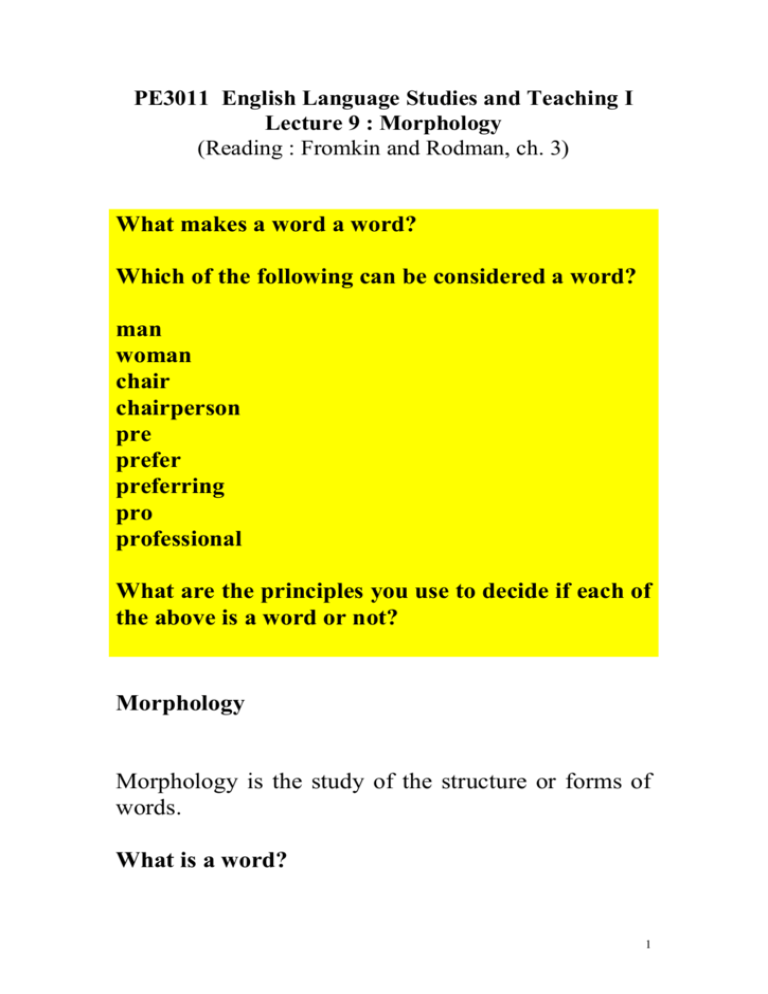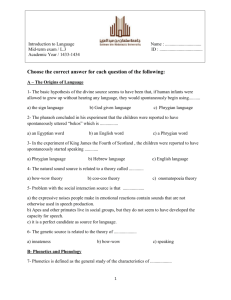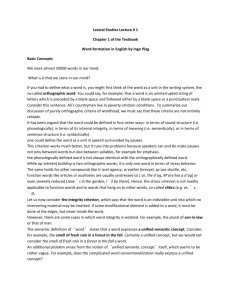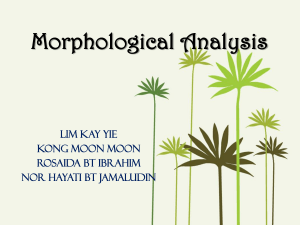Morphology
advertisement

PE3011 English Language Studies and Teaching I Lecture 9 : Morphology (Reading : Fromkin and Rodman, ch. 3) What makes a word a word? Which of the following can be considered a word? man woman chair chairperson pre prefer preferring pro professional What are the principles you use to decide if each of the above is a word or not? Morphology Morphology is the study of the structure or forms of words. What is a word? 1 I. Lexeme: One way to see the meaning of a word You don’t know the word ‘patronizing’. When you look up the word from your dictionary, which item will you look up? Patronize (patronise): an abstract word, which comes with different forms ‘patronize, patronizing, patronized, etc.’ Patronize: a lexeme which comes with different realizations in different contexts a lexeme which has a particular unit of meaning which can stand on its own A lexeme is the smallest, independent unit of meaning What are the lexemes of the following items? Confrontation Connotation Realization Kicking II. Morphemes: another way of looking at words 2 Small units of meaning which cannot exist on their own The meaning each unit (morpheme) represents can be ideational or functional They are building blocks of some English words. e.g., ‘un-’ in the word ‘undo’ (an ideational meaning of ‘not’) ‘es’ in ‘flashes’ (a functional meaning of plural marking or subject-verb agreement marking) ‘trans’ & ‘ion’ in the word ‘transportation’ (what meanings do the two morphemes carry?) Some words seem to come with some morphemes but the letters in them actually are not morphemes FUN Onion F+ un (x) On + ion(x) Do Ex. 2 (p.99) Fromkin & Rodman 3 Morphemes Vs Syllables Morphemes can be syllabic or non-syllabic e.g., ‘un~’ // as in the word ‘undo’ ‘~s’ /s/ as in the word ‘boys’ Types of Morphemes There are two major kinds of morphemes : Roots and Affixes Roots a morpheme which forms the base of a word, which usually contributes to a key/core part of meaning of a word. e.g., manly, problematic, terrifying Roots as free morphemes Roots that stand on its own e.g. MAN BOOK TABLE RED CAT BOY BIG They are normally what we mean when we talk about “words”. 4 Roots as bound morphemes: incapable of occurring in isolation they must always be attached to some other morpheme(s). e.g. -MIT perMIT, reMIT, comMIT, adMIT Affixes bound morphemes are attached to roots. Prefixes A prefix is an affix attached before a root. e.g. RE-make, UN-kind, IM-possible, DIS-trust, IN-accurate Suffixes A suffix is an affix attached after a root. e.g. kind-LY, wait-ER, art-IST, book-S, read-S, kind-NESS, care-FUL, care-LESS 5 Infixes incorporated inside the root; rare in English; fairly common in some other languages. e.g. in Kamhmu (a language spoken in South East Asia) see (to drill) toh (to chisel) hiip (to eat with a spoon) hoom (to tie) srnee (a drill) trnoh (a chisel) hrniip ( a spoon) hrnoom (a thing with which to tie) What is the infix here? What is its function? the infix -rn- is added to verbs to nominalize verbs In English, infixes are occasionally used by emotionally aroused speakers. e.g. The car hit a kangaBLOODYroo. HalleBLOODYluja III. Compounding: another way to look at words 6 A free morpheme + a free morpheme a. V-ing + Noun ironing board driving licence swimming pool chewing gum sailing boat shopping centre writing-pad c. Verb + Noun kill joy scarecrow spoil sport e. Adjective + Noun loudspeaker honeymoon greenhouse high brow b. d. Noun + Noun apron string city centre clock tower Bowland Tower Lake District tea spoon skin head Noun + Agentive Noun bookmaker bus driver screwdriver Do Ex. 3 p.99 (Fromkin & Rodman) 7 IV. Functions of morphemes: Inflectional and Derivational Morphemes IV.1 Derivational Morphemes added to words to change nature of a word: IV.1.1 changing the meaning of the base to which they are attached e.g. kind trust UN-kind DIS-trust happy moral UN-happy A-moral IV.1.2 changing the grammatical category that a word belongs to e.g. care care-ful boy exact sing predict haste alcohol care-FUL careful-NESS boy-ISH exact-LY sing-ER predict-ION haste-N alcohol-IC IV.2 Inflectional Morphemes Added to change form a word to give a grammatical fit into a particular grammatical slot. GIRL GIRLS (plural marker) 8 WALK WALKED (tense marker) SHORT SHORTER (comparative marker) e.g. long read read book long-ER read-S read-ING book-S short play John short-EST play-ED John’S Do Ex. 4 p.99 (Fromkin & Rodman) V. Generativity of morphemes Some of these rules are productive, meaning that they can be used freely to from new words from the list of free and bound morphemes. For instance, the derivational morpheme -ABLE (a suffix can be conjoined with any verb to derive an adjective). e.g., ? 9







